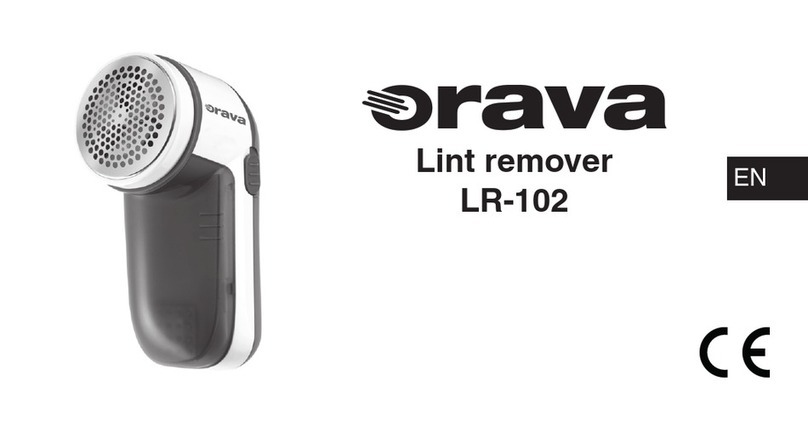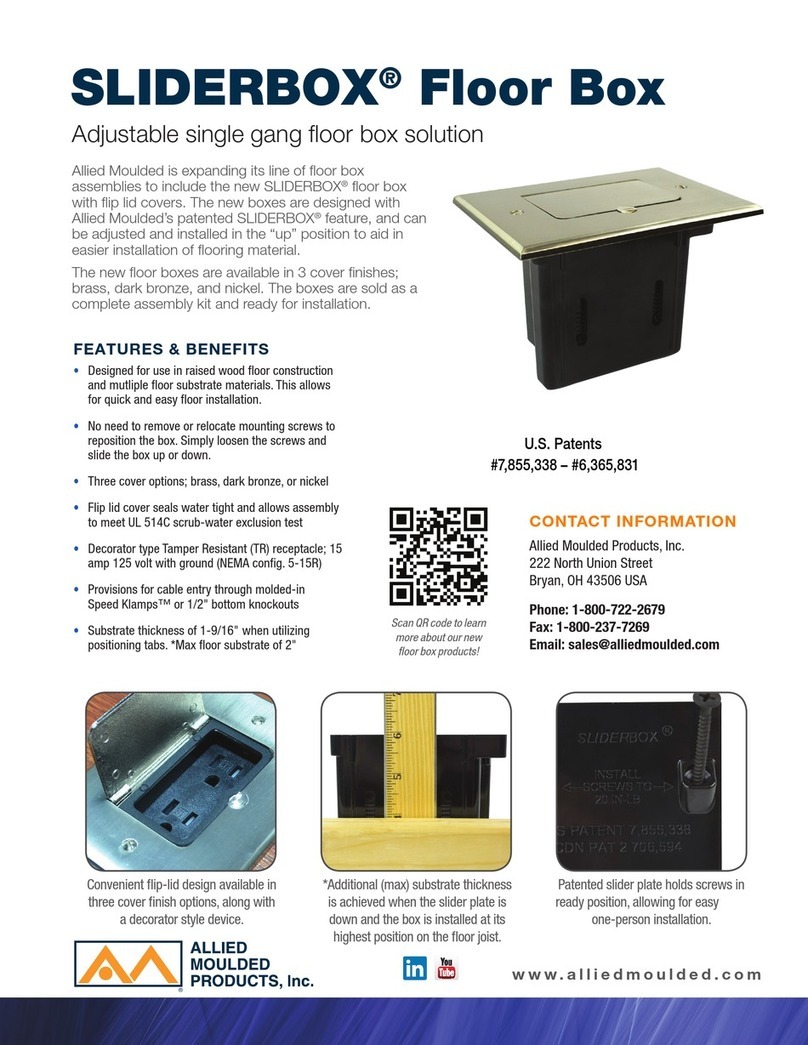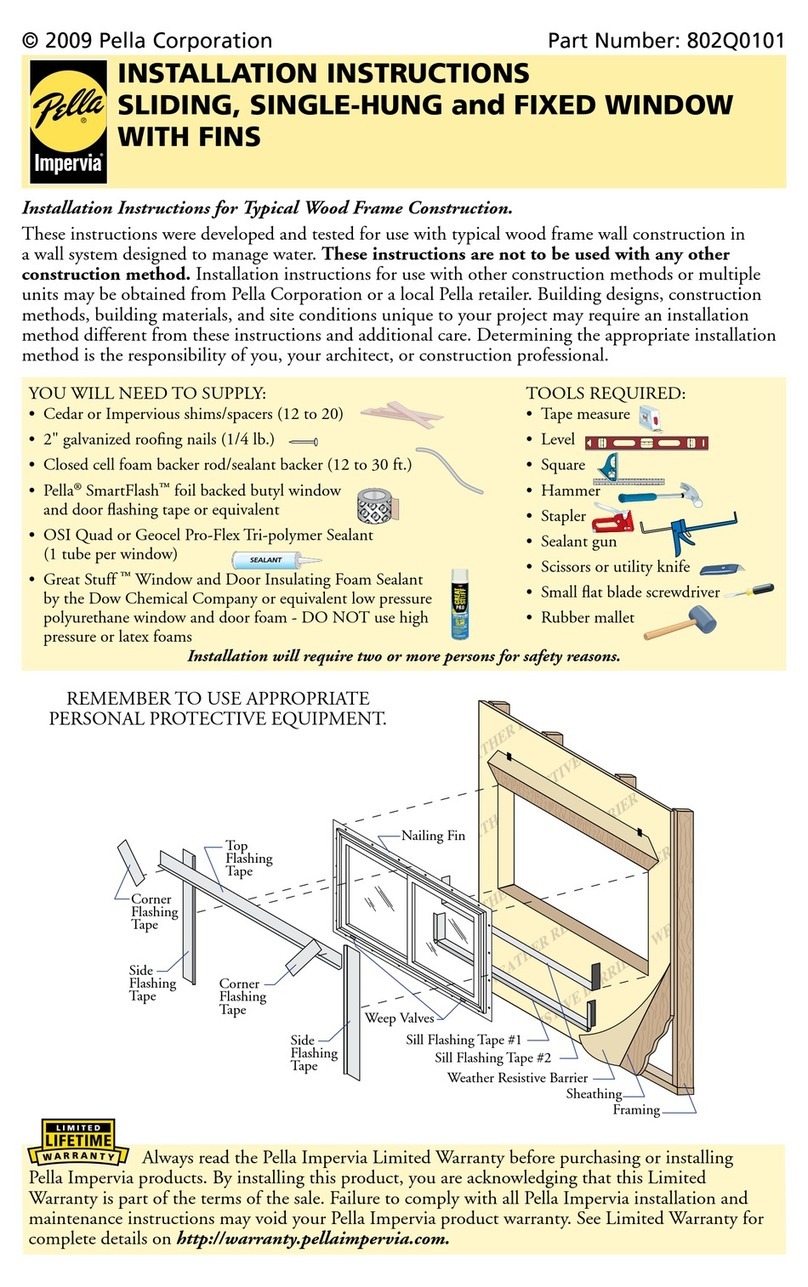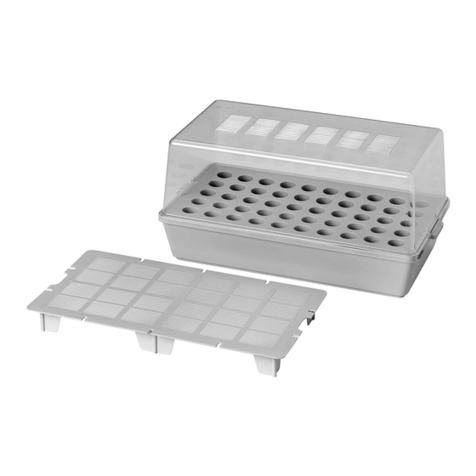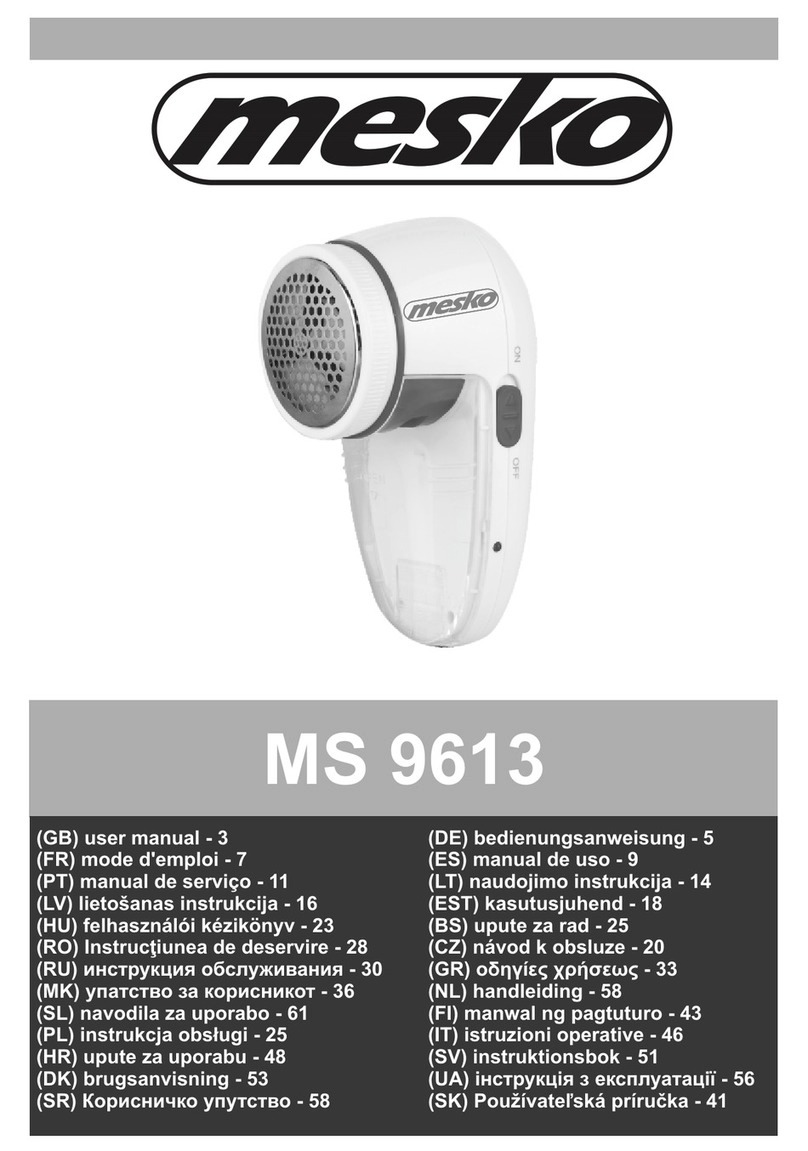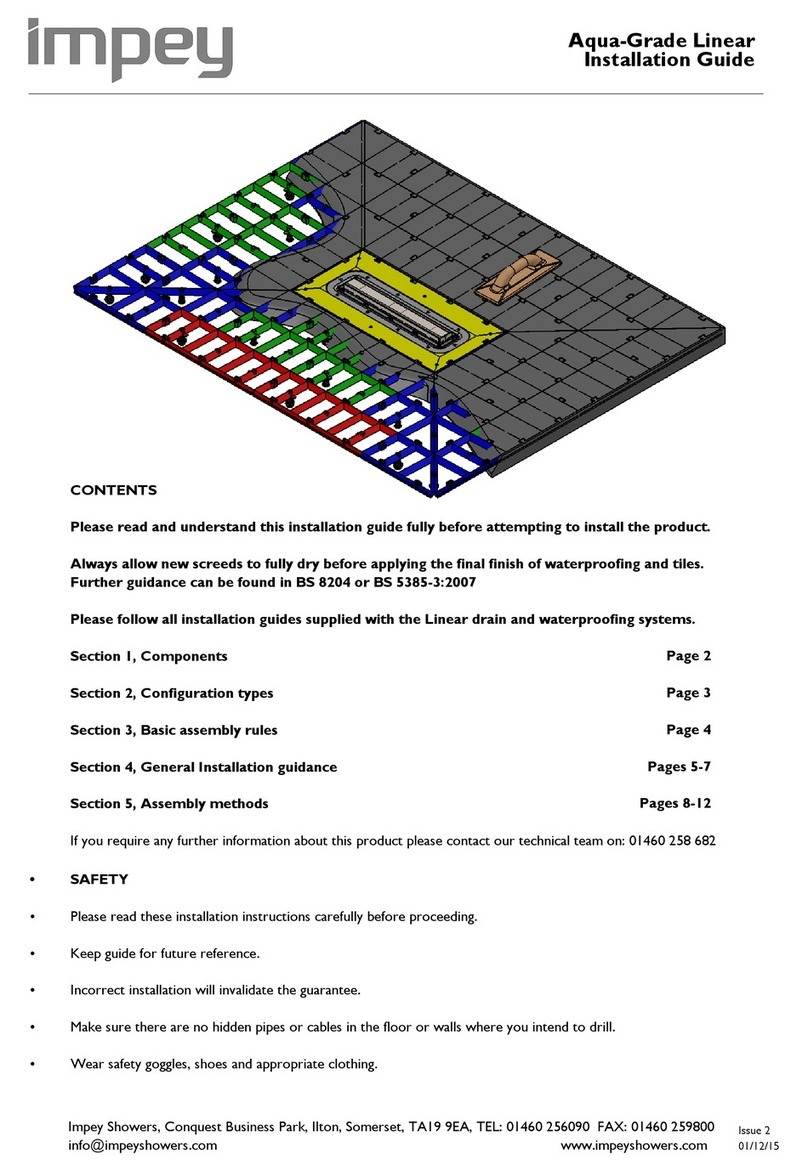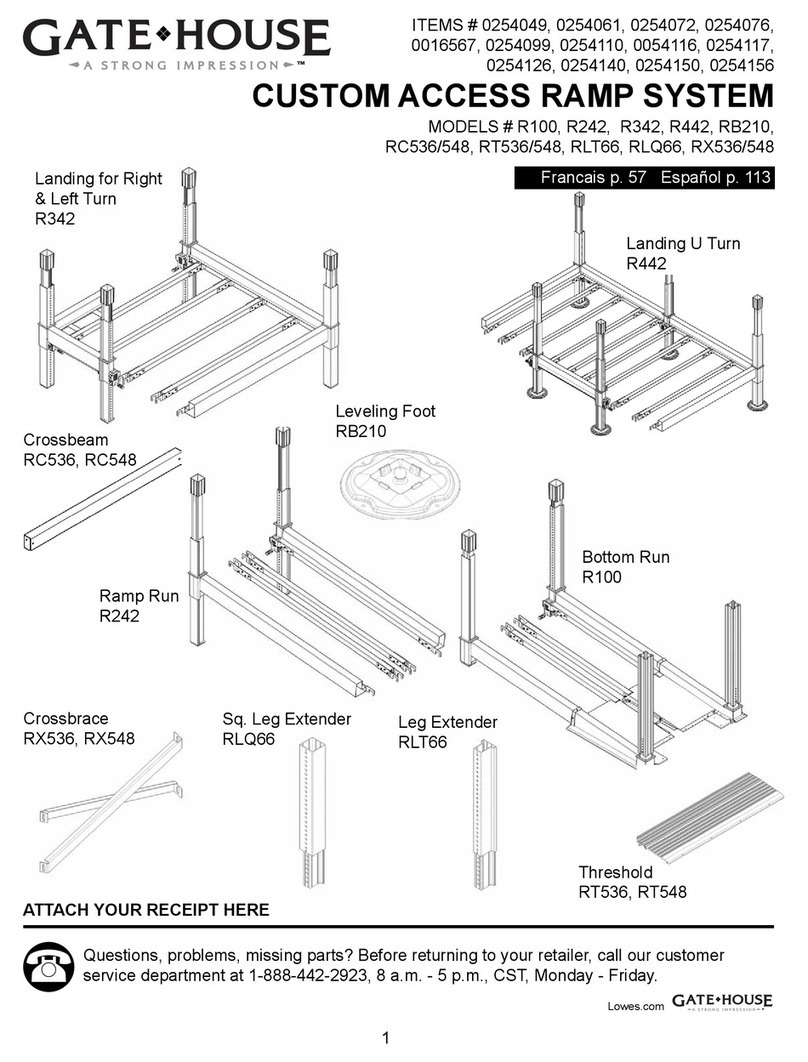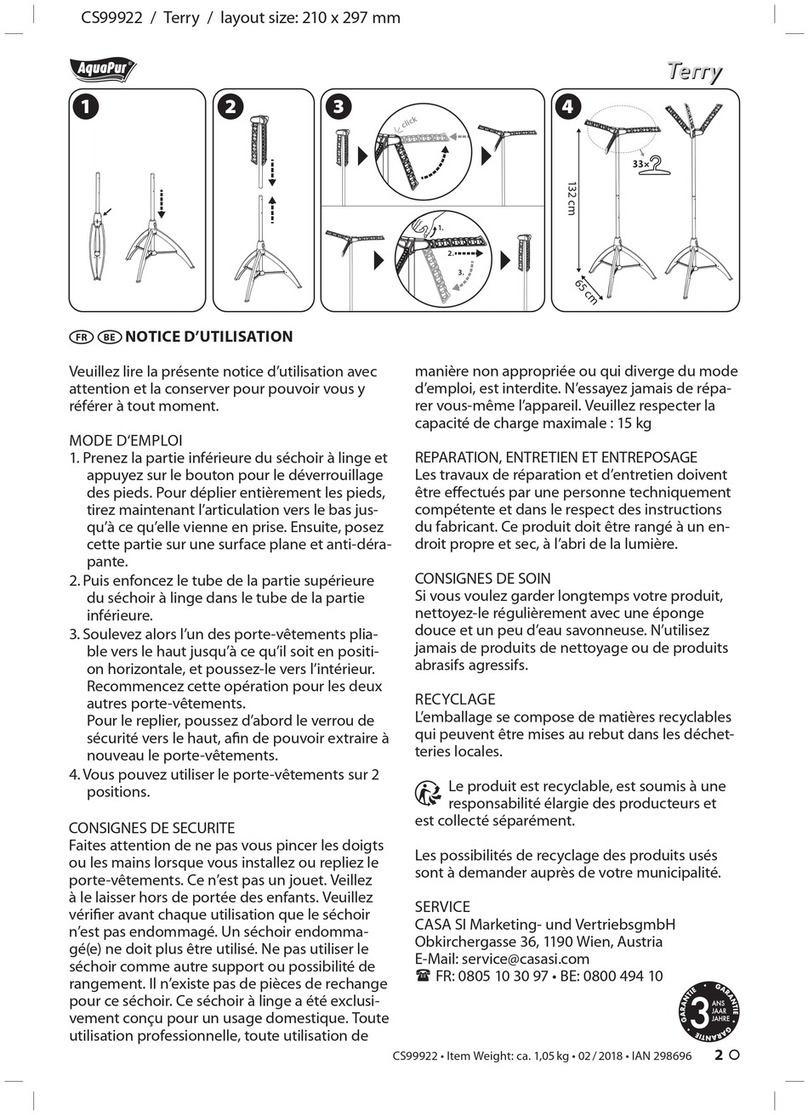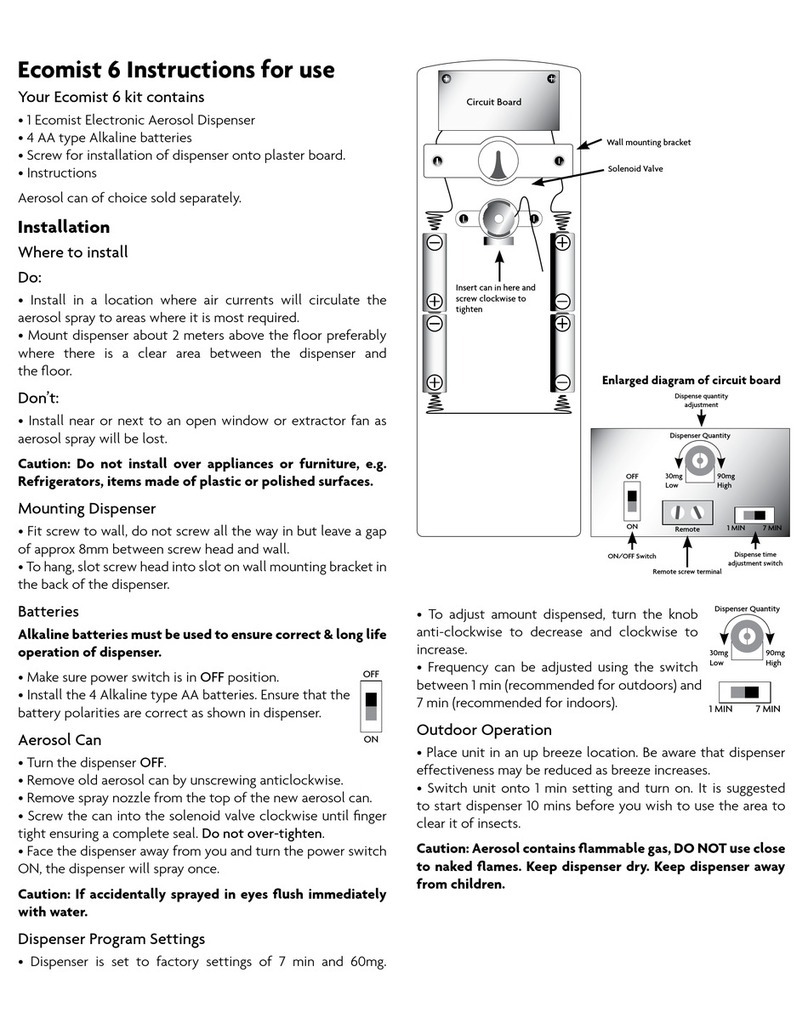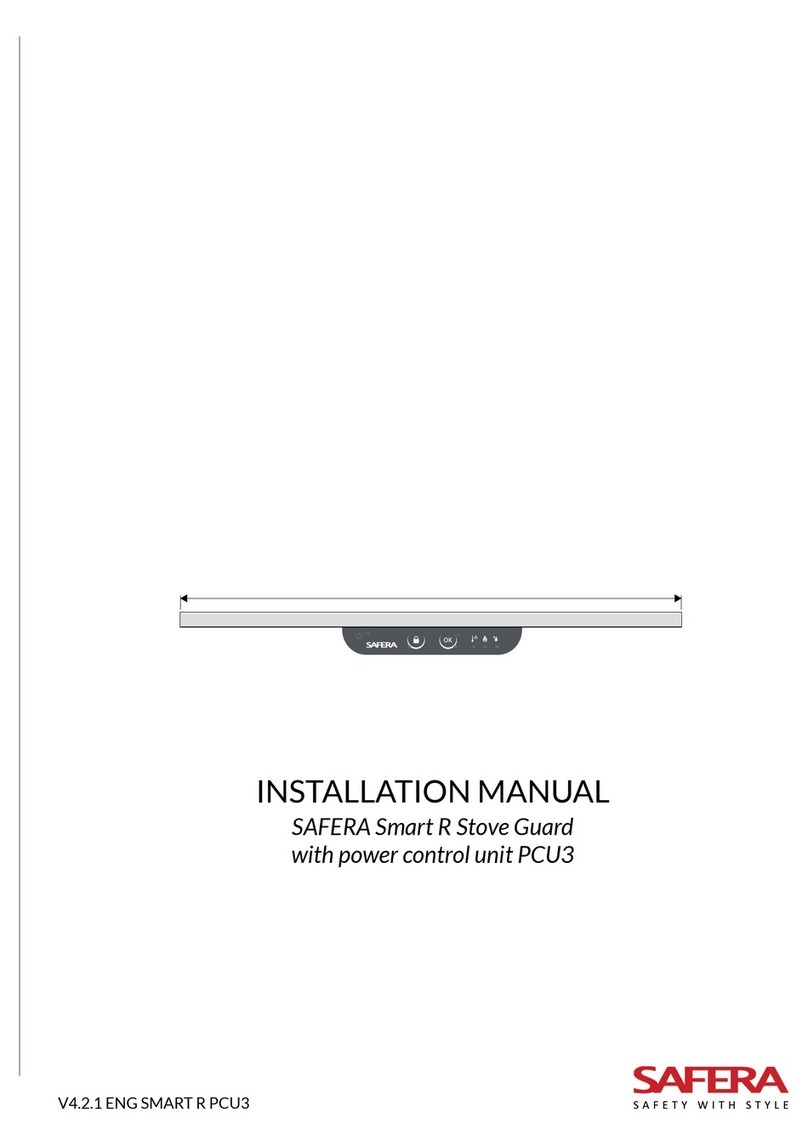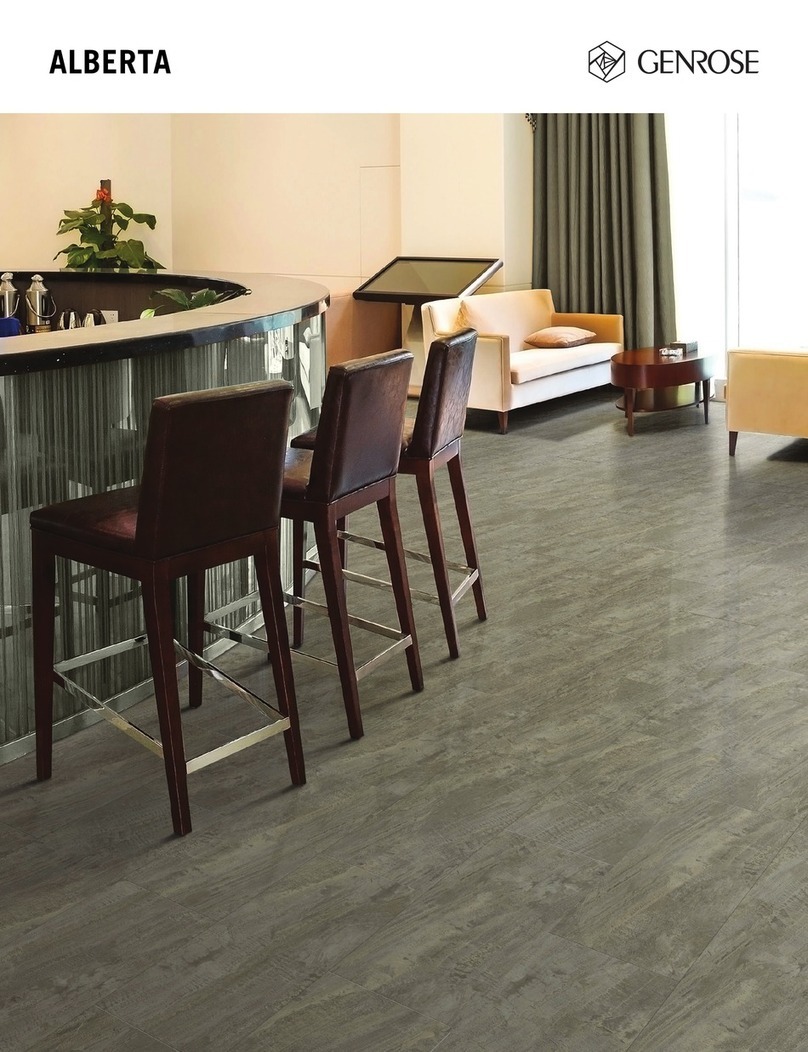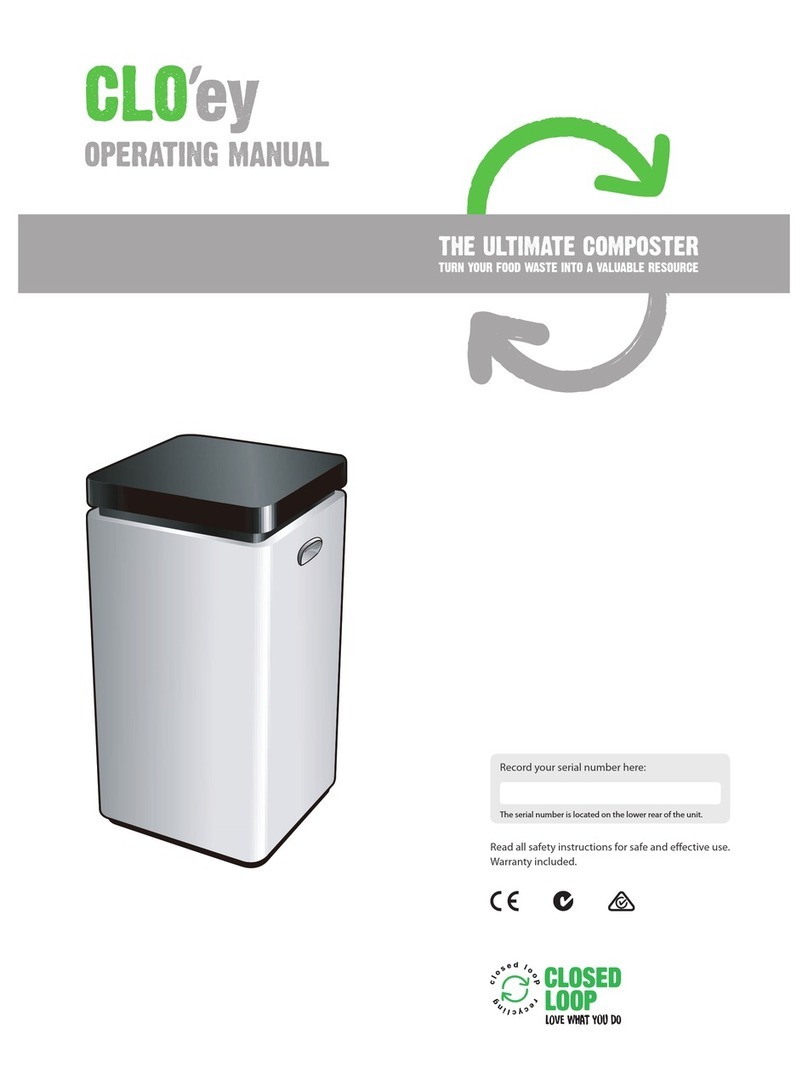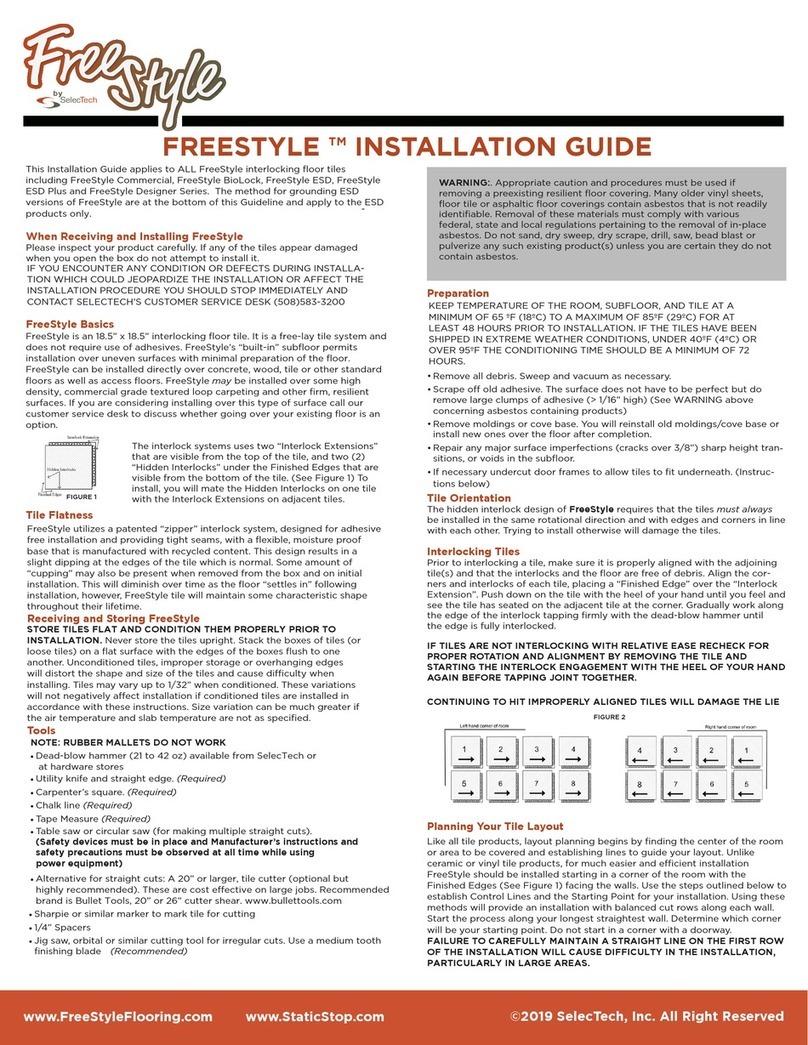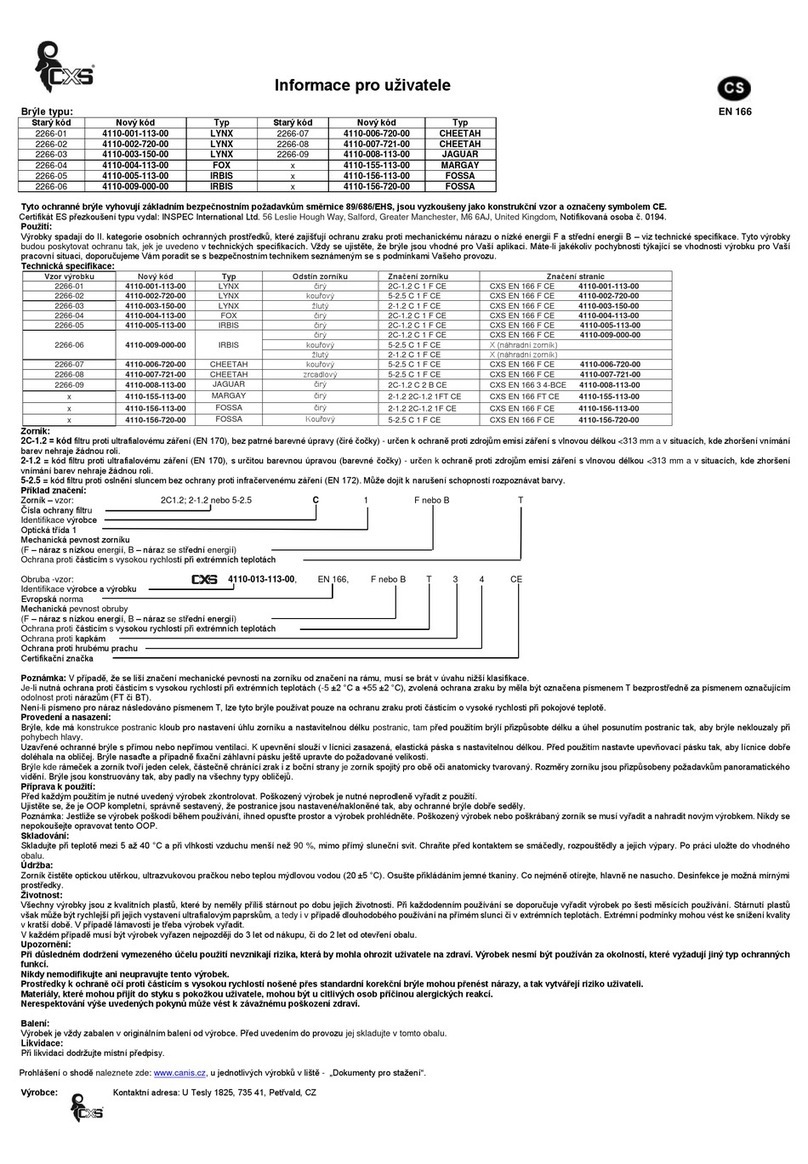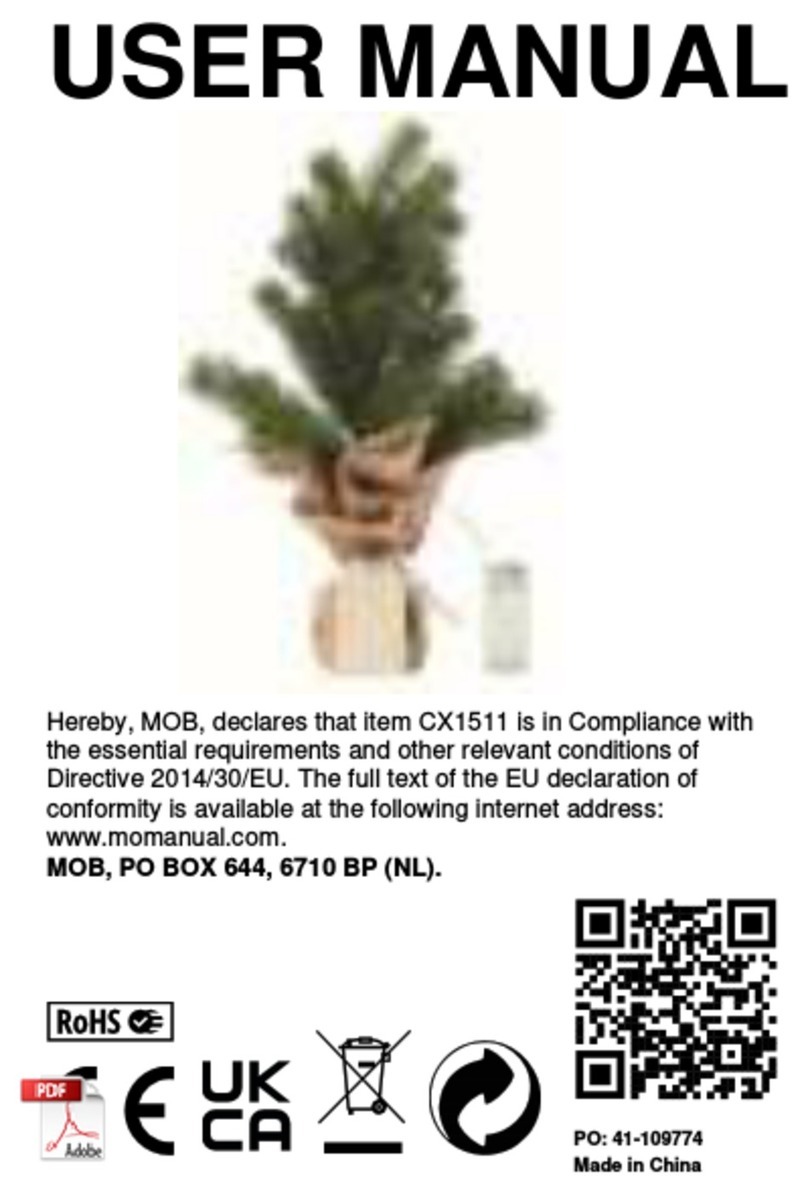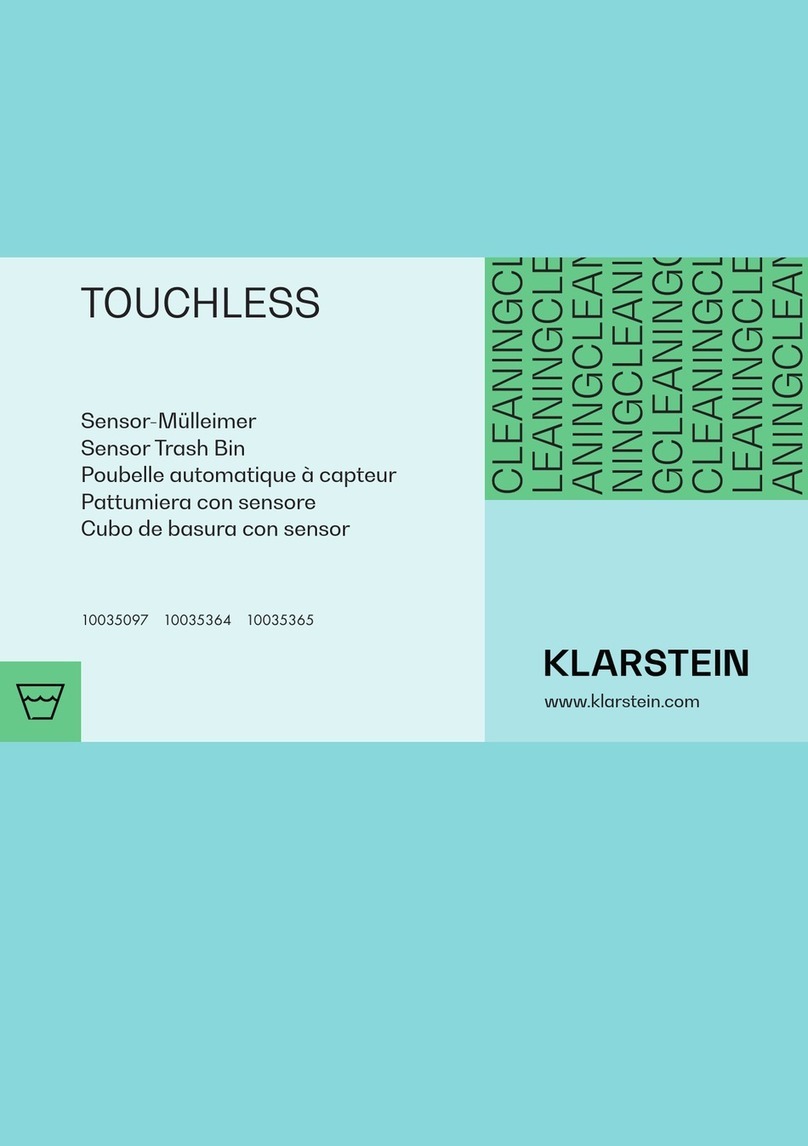Orava LR-103 User manual

Lint remover
LR-103 EN

2EN
The intended use of the device
The device is designed exclusively to remove clumps of fi ne
fi bers (junctions, knots) from the surface of the fabrics, to the
extent determined by technical and operating parameters and
functions, safety and user instructions and external infl uences of
the operating environment.
ORAVA electrical appliances are manufactured according
to the state of the art and recognized safety-technical rules.
Nevertheless, the use or use contrary to designation may result
in the risk of injury or endanger the life of the user or third person,
damage to the device and other material values.
1. GENERAL SAFETY INSTRUCTIONS AND WARNINGS
• This document contains important safety instructions and warnings
for safe, correct and economical operation of the electrical
equipment. Its compliance helps the user avoid risks, increase
reliability and product life.
• In this document, the general term product is used in text parts
such as:
electrical equipment - any device used for the production,
conversion, transmission, distribution or use of electricity.
• From the point of view of the purpose of using electricity, the
concept of electrical equipment in the strict sense of the word will
include the following categories:
- household electric appliances,
- information and communication equipment,
- consumer electronics,
- lighting equipment,
- electrical and electronic tools,
- toys and equipment for sporting and recreational purposes,
- medical devices (aids),
- monitoring and control devices,
- vending machines.
1.1 General safety instructions
• Before operating the unit, we recommend that you carefully
read the operating instructions and operate the equipment in
accordance with the instructions!
• The safety instructions and warnings in this manual do not cover all
the possible conditions and situations that may arise when using
the device. The user must understand that a factor that cannot be
incorporated into any of the products is personal responsibility and
caution. These factors must therefore be ensured by users serving
this device.

3EN
• Failure to follow the safety instructions and warnings is forbidden
by the manufacturer for any damage to property or property!
• Keep the operating instructions as close to the device as possible
throughout its service life. Always keep the operating instructions
together with the appliance for future use and use by new users.
• Use the appliance only for the intended purpose and in the manner
specifi ed by the manufacturer.
• The appliance is intended for home and similar indoor use without
special focus.
• This appliance is intended, in addition to domestic use, for the
following uses:
- in shops, offi ces and other similar work environments;
- in economic buildings;
- in hotels, motels and other residential environments;
- in bed and breakfast establishments.
• It is not a professional device for commercial use.
• Do not change the technical parameters and features of the device
by unauthorized modifi cation or modifi cation of any part of the
device.
• The manufacturer is not responsible for damages caused during
transportation, misuse, damage or destruction of the equipment
due to unfavorable weather conditions.
1.2 Safety of the operating environment
• Do not use the device in an industrial environment or outside
environment!
• Do not expose the appliance to:
- sources of excessive heat or open fl ame,
- dripping or splashing water,
- vibration and excessive mechanical stress,
- insects, animals and plants,
- aggressive and chemical substances.
• The operating environment of the device must always be in
accordance with the basic characteristics set.
• Features of the operating environment:
1. Ambient temperature: +5 ÷ +40 ° C
2. Humidity: 5 ÷ 85%
3. Altitude: ≤ 2 000 m
4. Occurrence of water: intermittent condensation of water or
occurrence of water vapor
5. Occurrence of foreign bodies: quantity and type of dust are
insignifi cant
6. Protection degree: min. IP20 (device protected from touching
dangerous parts by hand and non-waterproof)

4EN
• This degree of protection is not indicated on the product and on the
technical parameters in the operating instructions.
• If the protection class of the product is different from IPX0, this
information is then displayed on the device label or in the technical
manuals of the operating instructions.
• Other characteristics of the domestic operating environment
(mechanical stress - vibrations and vibrations, occurrence of plant,
animals, weather effects ...) are negligible in terms of effect on the
correct and safe use of electrical equipment.
1.3 Electrical safety
• Before connecting the appliance to the power supply for the
fi rst time, make sure that the voltage on the appliance label
corresponds to that of the household electrical outlet.
• The electrical appliance is designed to power from 1/N/PE ~ 230
V 50 Hz.
• The electrical safety of the appliance is guaranteed only if it is
properly connected to the mains.
• Electrical protection class I equipment is equipped with a
protection against electric shock by means of protective earthing of
inanimate parts, which can become dangerous when the device is
malfunctioning. Always connect such devices to properly installed
mains sockets that are equipped with earthing conductors and
have a properly grounded earthing conductor.
All electrical equipment is equipped with a three-wire power supply.
• Class II electrical equipment is protected against electric shock
by double insulation or by enhanced insulation of hazardous live
electrical parts. The Class II device must not be equipped with
means to connect a protective ground.
All electrical equipment is equipped with two-wire power supply.
• Class III electrical equipment is a device that is powered by a small
safe voltage source (battery or accumulator) and does not present
any danger to the user from electrical shock.
• In order to provide increased safety against the risk of electric
shock due to the use of electrical appliances by laypersons, it is
recommended to install the power supply circuit for sockets with
a rated current not exceeding 20 A RCD with a rated operating
current not exceeding 30 mA.
To ensure the safety and correctness of the electrical installation,
consult a qualifi ed electrician.

5EN
• Only use a power cord with a plug (mains lead) supplied with the
device and compatible with a wall outlet. Using another cable may
result in fi re or electric shock.
Always connect an electrical appliance to an easily accessible
power socket. In the event of an operating fault, the appliance must
be switched off as soon as possible and disconnected from mains
supply.
• The power cord and mains plug must always be easily accessible
for safe disconnection of the electrical appliance from the power
supply.
• Do not pull the power cord by pulling on the cord. Disconnect the
power cord by pulling the plug behind the power cord/power cord
plug.
• If you use an extension cord, make sure that the total rated power
of all devices connected to the extension cord does not exceed the
max. current load on the extension cable.
• If you need to use an extension cord or power supply block,
make sure that the extension cord or power pack is plugged into
an electrical outlet and not to another extension cord or power
supply. The extension power cord or power supply block must be
designed for grounded electrical plugs and connected to a properly
grounded electrical socket.
• The power plug of the appliance must be compatible with the mains
socket. Never use any adapters or modify the socket in any other
way. Do not use inappropriate or damaged sockets!
• To avoid electrical shock, plug the power cables into properly
grounded electrical sockets. If the device is equipped with a 3-pole
plug, do not use adapters that do not have a grounding element or
remove the grounding element from the plug or adapter.
• Do not bend, crush or otherwise expose the power cord of the
appliance to mechanical stress or external heat sources. Damage
to the power cord may result in electric shock.
• If the power cord is damaged, disconnect the appliance from the
mains and do not use it again.
• If the power cord is damaged, it must be replaced by the
manufacturer, its service department or a similarly qualifi ed person
to avoid the risk of electric shock.
• Regularly check and maintain the electrical appliance as well as
the power cord and power socket. Plug the power plug off regularly
and clean it if necessary. Pollution by dust or other substances
may cause disruption of the insulating state and consequently fi re.

6EN
• Do not expose the appliance to water or moisture. The ingress
of water into the appliance increases the risk of electric shock.
If the power cord is wet or the water has penetrated the water,
disconnect it immediately from the mains. If the appliance is
plugged into a mains socket and if possible, turn off the power
supply before attempting to disconnect the power supply. If you are
pulling wet wires from a live power source, be very careful.
• If the electrical equipment is installed (connecting) the protective
covers are dismantled, the electrical parts must not be accessible
to the user when the installation is fi nished.
1.4 Safety of persons
• This appliance is intended for use and operation by persons
without electrotechnical qualifi cation - lay people, according to the
instructions specifi ed by the manufacturer.
• Device operation includes activities such as switching on and off,
user manipulation and setting of operating parameters, visual
or auditory inspection of the equipment, and user cleaning and
maintenance.
• This appliance can be used by children under the age of 8 and
persons with reduced physical, sensory or mental capabilities or
lack of experience or knowledge when supervised or instructed
in the safe use of the appliance and understand the dangers
involved.
• Children may not play with the appliance.
• Cleaning and maintenance for users may not be performed by
children unattended.
• Always keep the appliance out of reach of children during use and
operation. Be sure to download the appliance even for a freely
accessible power cord.
• Always be careful when operating the electric appliance! Do not
use an electric appliance if you are overly tired, under the infl uence
of medication or narcotic drugs that reduce attention and focus.
• Inattention during operation may result in serious injury.

7EN
1.5 Cleaning, maintenance and repairs
• Observe the normal user cleaning and maintenance of the
appliance in the recommended way. Do not use solvents or harsh
cleaners for cleaning. Pollution and visible stains from fi nger
contact, respectively. hands can be cleaned using detergent
detergents specially designed to clean household appliances.
• If you do not use the appliance, clean it or disconnect the appliance
from the power supply when the appliance is faulty.
• Electrical appliances that are cleaned after use and are not
intended to be completely or partially immersed in water or other
liquid, protect against the effects of dripping and / or splashing
water and before immersion.
• Electric household appliances, like all other technical devices, are
subject to the surrounding environment and natural wear. Since
the legal framework of regular maintenance is not laid down for
lay-in household appliances, the manufacturer recommends that
the user have the appliance checked and cleaned at least once a
year by a specialist workshop.
• By doing so, it is possible to achieve safety, operational reliability
and increased service life.
• Do not disassemble the electric appliance! The appliance works
with a dangerous voltage. For this reason, always switch off
the appliance and disconnect it from the mains supply during
user maintenance. In the event of a fault, please have the repair
serviced by an authorized service center.
• Before calling a service:
1. Turn the appliance off and on to make sure the fault reappears.
2. If the malfunction of the appliance persists even after the above
operations, call the nearest professional service.
• Never repair the electric appliance yourself!
• Unauthorized, unqualifi ed and improper use of an electric
appliance may result in electric shock or other serious injury.
• Only carry out the warranty or post-warranty repair of an electrical
appliance to an authorized qualifi ed person (*).
(*) Competent qualifi ed expert: the sales department of the manufacturer
or importer or the person qualifi ed and authorized to carry out this type of
activity with the ability to avoid all risks.

8EN
2. Special Safety Instructions.
Read carefully!
• Electrical equipment is designed and manufactured in such a
way as to allow for safe operation and use by persons without a
professional qualifi cation. Despite all the measures taken by the
manufacturer to ensure safe use, handling and use, it carries with
it some residual risks and associated potential hazards.
• To warn of possible hazards, the following symbols and their
meanings have been used on the device and in the accompanying
documentation:
This symbol alerts users that the device is operating a
dangerous electrical voltage. Do not remove protective
covers on the device.
Failure to observe the safety instructions during use and
operation of the unit may entail the following: Danger of
electric shock!
Danger of serious injury or life threatening!
This symbol alerts users that the following precautions can
be avoided if the following precautions are observed when
operating and operating the device:
Danger of serious injury or life threatening! Danger of
damage to equipment or other damage to property!
This symbol indicates that the product is equipped with
circuits in which the maximum electrical voltage does not
exceed the permitted values of the low safe voltage. Such
a device cannot cause electric shock when it comes into
contact with live parts in normal operation or with
non-live parts in the event of equipment failure.
Transport/Carriage
• When transporting and transporting, be careful when moving, to
prevent overturning, falling and damage to the device.
There is a risk of damage to the device!
Unpacking/Packaging
• Unpack the equipment and accessories before putting it into
service and remove all parts of the packaging material, labels and
labels.
• Store the packaging in a safe place or keep it out of the reach of
children and inappropriate persons.
There is a risk of serious injury!
There is a risk of choking!

9EN
Check/Comissioning
• We recommend performing both initial and subsequent periodic
inspections of the device. Only use the device with accessories
supplied and approved by the manufacturer.
• Never use the device if it is incomplete or damaged during use has
been damaged parts or accessories (eg. By being dropped, wear).
There is a risk of serious injury!
• Check and assemble the machine before operating it as described
in „Before Use“.
• Never clean the device (body with electrical parts) in a way that it
could get into the liquid and fl ood the liquid into the device.
• Clean the electrical parts with a damp cloth only and wipe dry or
let it dry.
• Keep the appliance clean and dry.
• If the device was stored at low temperatures, fi rst acclimate (about
½ to 1 hour) before further use to remove any moisture inside the
enclosure, solidify the moving parts and preserve the mechanical
strength of the plastic parts.
Operation/Use
Warning!
• The device is intended for use with a power supply with a
built-in rechargeable battery that is not user-replaceable.
• Only a qualifi ed service technician may replace the
battery.
Caution!
• Do not use a device with an AC power cord when the
cord or its parts are damaged. Do not repair the cord by
yourself self.
Ask a specialist service to replace the power cord with the
same type. There is a risk of electric shock!
• The device is suitable for removing smears that occur on
the surface of fabrics and fabrics due to wearing of textiles
or weaving of fabric and human body.
• Resins are most often formed on the surface of textiles
made of synthetic and especially polyester fi bers and
textiles containing these materials.
• To avoid damage or degradation of the garment or fabric,
always check the suitability of using the device on a small,
wearable, minor area.
• The device is not suitable for removing fi bers from very
thin materials such as silk, microfi bre, and the like. The
structure of the material may be damaged.

10EN
Caution!
• Never use the appliance to remove hair from parts of the
human body.
There is a risk of serious injury!
Caution!
• Always make sure that the machine is switched off by the
main switch before handling any equipment (common use,
cleaning, etc.).
• Do not switch on or use the appliance unless the rotary
blade planer is correctly seated and threaded on the
machine.
• Rotary blades move at high speed and are very sharp.
• At the same time, the knife and knife blade can be
damaged.
• Do not use the device when the blade of the rotary blades
is damaged (eg broken, ruptured or missing part of the
metal perforated surface).
• Do not use the appliance when the jar and fi ber trays are
planted.
There is a risk of serious injury!
There is a risk of damage to the device!
• Do not use a device to remove junk from clothing directly
on people.
• Do not use the appliance on damp and wet fabrics.
Moisture in the fi bers of the fabric results in clogging and
contaminating the device and reducing the effect of the
rotary knives.
• Do not use the appliance on textiles that are dirty with
solid and hard dirt.
• Do not expose any hard objects (such as metal fi bers,
wires, etc.) to the planes. These items can damage or
even destroy planchette and rotary knives.
There is a risk of damage to the device!
• Use the machine only on fl at and fi rm washers. Do not use
the device on soft, uneven or high-loose mats.
There is a risk of damage to the device!
There is a risk of damage to the fabric!
Warning!
• Use the device on textiles that are straight, well-tightened
and do not contain signifi cant irregularities or folds.
Table of contents
Other Orava Household Appliance manuals
